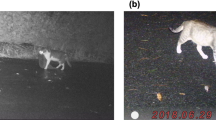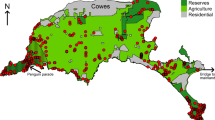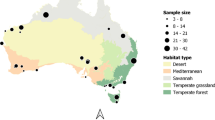Abstract
The impacts of invasive predators can be amplified by high densities of invasive prey species. In Australia, hyper abundant rabbit populations lead to high densities of feral cats and correspondingly high impact of cats on native species, especially small mammals. Therefore, it would be expected reducing rabbits could also reduce abundance of cats, and thereby alleviate predation on native small mammals. However, cats might respond to the loss of rabbits by prey-switching to native small mammals, resulting in increased predation on those species. Our aim was to understand the short-term effects of an experimental reduction of rabbit abundance on feral cats and their small-mammal prey in arid South Australia. We reduced the rabbit population in a 37 km2 experimental enclosure by ~ 80%, while monitoring an adjacent unmanipulated area as a control. Cat activity and survival of VHF-collared cats in the enclosure decreased by 40% following the rabbit reduction. Surviving cats increased their consumption of reptiles, birds and invertebrates, but they nevertheless evinced hunger by increased intake of experimentally-supplied sausages. There was no change in either the proportion of cat scats that contained remains of small mammals, or the rate at which video-collared cats were recorded killing small mammals, even though the activity of small mammals declined. Our results demonstrate that individual feral cats prey-switch in response to removal of their primary prey. However, we also show that survival and overall activity of cats decreased, which could result in net, long-term benefits for native prey threatened by cats. Management of feral cats using food lures or baits would also be more effective when introduced prey are scarce, as cats are more likely to eat novel food.





Similar content being viewed by others
References
Abrams PA, Holt RD, Roth JD (1998) Apparent competition or apparent mutualism? Shared predation when populations cycle. Ecology 79(1):201–212
Algar D, Angus GJ, Williams MR, Mellican AE (2007) Influence of bait type, weather and prey abundance on bait uptake by feral cats (Felis catus) on Peron Peninsula, Western Australia. Conserv Sci West Aust 6(1):109–149
Burbidge AA, Manly BFJ (2002) Mammal extinctions on Australian islands: causes and conservation implications. J Biogeogr 29(4):465–473
Burnham KP, Anderson DR (1998) Model selection and multimodel inference: a practical information-theoretic approach. Springer, Berlin
Christensen PE, Ward BG, Sims C (2013) Predicting bait uptake by feral cats, Felis catus, in semi-arid environments. Ecol Manag Restor 14(1):47–53
Courchamp F, Langlais M, Sugihara G (2000) Rabbits killing birds: modelling the hyperpredation process. J Anim Ecol 69(1):154–164
Delibes-Mateos M, De Simon JF, Villafuerte R, Ferreras P (2008) Feeding responses of the red fox (Vulpes vulpes) to different wild rabbit (Oryctolagus cuniculus) densities: a regional approach. Eur J Wildl Res 54(1):71–78
Dickman CR, Newsome TM (2015) Individual hunting behaviour and prey specialisation in the house cat Felis catus: implications for conservation and management. Appl Anim Behav Sci 173:76–87
Doherty T, Davis RA, Etten EJB, Algar D, Collier N, Dickman CR, Edwards GP, Masters P, Palmer R, Robinson S (2015a) A continental-scale analysis of feral cat diet in Australia. J Biogeogr 42(5):964–975
Doherty TS, Dickman CR, Nimmo DG, Ritchie EG (2015b) Multiple threats, or multiplying the threats? Interactions between invasive predators and other ecological disturbances. Biol Conserv 190:60–68
Griffin AS, Blumstein DT, Evans CS (2000) Training captive-bred or translocated animals to avoid predators. Conserv Biol 14(5):1317–1326
Holden C, Mutze G (2002) Impact of rabbit haemorrhagic disease on introduced predators in the Flinders Ranges, South Australia. Wildl Res 29(6):615–626
Jones E, Coman B (1981) Ecology of the Feral Cat, Felis catus (L.), in South-Eastern Australia I. Diet. Wildl Res 8(3):537–547
Kruuk H (1972) Surplus killing by carnivores. J Zool 166(2):233–244
Loyd KAT, Hernandez SM, Carroll JP, Abernathy KJ, Marshall GJ (2013) Quantifying free-roaming domestic cat predation using animal-borne video cameras. Biol Conserv 160:183–189
McGregor HW, Legge S, Jones ME, Johnson CN (2015) Feral cats are better killers in open habitats, revealed by animal-borne video. PLoS ONE 10(8):e0133915
Molsher R, Newsome A, Dickman CR (1999) Feeding ecology and population dynamics of the feral cat (Felis catus) in relation to the availability of prey in central-eastern New South Wales. Wildl Res 26(5):593–607
Moseby K, Read J, Gee P, Gee I (1998) A study of the Davenport Range black-footed rock wallaby colony and possible threatening processes. Final report to Wildlife Conservation Fund. Department for Environment and Heritage, Adelaide
Moseby KE, Neilly H, Read JL, Crisp HA (2012) Interactions between a top order predator and exotic mesopredators in the Australian rangelands. Int J Ecol 2012:1–15
Moseby KE, Peacock DE, Read JL (2015) Catastrophic cat predation: a call for predator profiling in wildlife protection programs. Biol Conserv 191:331–340
Moseby KE, Blumstein DT, Letnic M (2016) Harnessing natural selection to tackle the problem of prey naïveté. Evol Appl 9(2):334–343
Moseby K, Crowther M, Letnic M (2018) Ecological role of an apex predator revealed by a reintroduction experiment and Bayesian statistics. Ecosystems 2018:1–13
Moseby K, McGregor H, Hill BM, Read J (2019) Exploring the internal and external wildlife gradients created by conservation fences. Conserv Biol 2019:1–12
Murphy EC, Keedwell RJ, Brown KP, Westbrooke I (2005) Diet of mammalian predators in braided river beds in the central South Island, New Zealand. Wildl Res 31(6):631–638
Mutze G (2017) Continental-scale analysis of feral cat diet in Australia, prey-switching and the risk: benefit of rabbit control. J Biogeogr 44(7):1679–1681
Mutze G, Cooke B, Alexander P (1998) The initial impact of rabbit hemorrhagic disease on European rabbit populations in South Australia. J Wildl Dis 34(2):221–227
Norbury G, Byrom A, Pech R, Smith J, Clarke D, Anderson D, Forrester G (2013) Invasive mammals and habitat modification interact to generate unforeseen outcomes for indigenous fauna. Ecol Appl 23(7):1707–1721
Paolucci EM, MacIsaac HJ, Ricciardi A (2013) Origin matters: alien consumers inflict greater damage on prey populations than do native consumers. Divers Distrib 19(8):988–995
Pech RP, Hood G (1998) Foxes, rabbits, alternative prey and rabbit calicivirus disease: consequences of a new biological control agent for an outbreaking species in Australia. J Appl Ecol 35(3):434–453
Pech RP, Sinclair A, Newsome A, Catling P (1992) Limits to predator regulation of rabbits in Australia: evidence from predator-removal experiments. Oecologia 89(1):102–112
Pedler RD, Brandle R, Read JL, Southgate R, Bird P, Moseby KE (2016) Rabbit biocontrol and landscape-scale recovery of threatened desert mammals. Conserv Biol 30:774–782
Radford JQ, Woinarski JCZ, Legge S, Baseler M, Bentley J, Burbidge AA, Bode M, Copley P, Dexter N, Dickman CR, Gillespie G, Hill B, Johnson CN, Kanowski J, Latch P, Letnic M, Manning A, Menkhorst P, Mitchell N, Morris K, Moseby K, Page M, Ringma J (2018) Degrees of population-level susceptibility of Australian terrestrial non-volant mammal species to predation by the introduced red fox (Vulpes vulpes) and feral cat (Felis catus). Wildl Res 45(7):645–657
Read J, Bowen Z (2001) Population dynamics, diet and aspects of the biology of feral cats and foxes in arid South Australia. Wildl Res 28(2):195–203
Saunders G, Berghout M, Kay B, Triggs B, Ven RVD, Winstanley R (2004) The diet of foxes Vulpes vulpes in south-eastern Australia and the potential effects of rabbit haemorrhagic disease. Wildl Res 31(1):13–18
Scroggie MP, Forsyth DM, McPhee SR, Matthews J, Stuart IG, Stamation KA, Lindeman M, Ramsey DS (2018) Invasive prey controlling invasive predators? European rabbit abundance does not determine red fox population dynamics. J Appl Ecol 55(6):2621–2631
Short J, Kinnear JE, Robley A (2002) Surplus killing by introduced predators in Australia—evidence for ineffective anti-predator adaptations in native prey species? Biol Conserv 103(3):283–301
Smith AP, Quin DG (1996) Patterns and causes of extinction and decline in Australian conilurine rodents. Biol Conserv 77(2):243–267
Therneau, T.M. (2014) A package for survival analysis in R package
Vermeij GJ (1991) When biotas meet: understanding biotic interchange. Science 253(5024):1099–1104
Webb SD (1985) The great American biotic interchange. Springer, Berlin, pp 357–386
Woinarski JCZ, Burbidge AA, Harrison PL (2015) Ongoing unraveling of a continental fauna: decline and extinction of Australian mammals since European settlement. Proc Natl Acad Sci 112(15):4531–4540
Wysong ML, Tulloch AIT, Valentine LE, Hobbs RJ, Morris K, Ritchie EG (2019) The truth about cats and dogs: assessment of apex- and mesopredator diets improves with reduced observer uncertainty. J Mamm 100(2):410–422
Yip SJ, Rich M-A, Dickman CR (2015) Diet of the feral cat, Felis catus, in central Australian grassland habitats during population cycles of its principal prey. Mamm Res 60(1):39–50
Acknowledgements
Arid Recovery hosted and supported this project. They are an independent conservation and research initiative supported by BHP, The University of Adelaide, Bush Heritage Australia and The South Australian Department for Environment and Water. The rabbit removal effort was conducted by Frank Bernhardt (Bernhardt’’s Pest & Weed Control). Zac Richardson assisted with field data collection. Menna Jones, Greg Mutze, David Peacock, and Reece Pedler assisted with project development. Katherine Tuft and Catherine Lynch provided logistical support. Two anonymous reviewers provided expert advice for improving this manuscript. H McG and SL are supported by the National Environmental Program’s Threatened Species Recovery Hub.
Author information
Authors and Affiliations
Contributions
All authors conceived the ideas and designed methodology; HM collected and analyzed the data; HM led writing of the manuscript; and all authors contributed critically to the drafts and gave final approval.
Corresponding author
Ethics declarations
Conflict of interest
The authors declare that they have no conflict of interest.
Ethical approval
Data collection fulfilled all legal requirements in Australia, and methods were approved by University of Tasmania Animal Ethics Committee (A0015720).
Additional information
Publisher's Note
Springer Nature remains neutral with regard to jurisdictional claims in published maps and institutional affiliations.
Rights and permissions
About this article
Cite this article
McGregor, H., Moseby, K., Johnson, C.N. et al. The short-term response of feral cats to rabbit population decline: Are alternative native prey more at risk?. Biol Invasions 22, 799–811 (2020). https://doi.org/10.1007/s10530-019-02131-5
Received:
Accepted:
Published:
Issue Date:
DOI: https://doi.org/10.1007/s10530-019-02131-5




